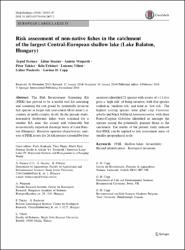| dc.contributor.author | Ferincz, Arpad | |
| dc.contributor.author | Staszny, Adam | |
| dc.contributor.author | Weiperth, Andras | |
| dc.contributor.author | Takacs, Peter | |
| dc.contributor.author | Urbanyi, Bela | |
| dc.contributor.author | Vilizzi, Lorenzo | |
| dc.contributor.author | Copp, Gordon H. | |
| dc.date.accessioned | 2020-11-20T15:02:02Z | |
| dc.date.available | 2020-11-20T15:02:02Z | |
| dc.date.issued | 2016 | |
| dc.identifier.issn | 0018-8158 | |
| dc.identifier.issn | 1573-5117 | |
| dc.identifier.uri | https://doi.org/10.1007/s10750-016-2657-2 | |
| dc.identifier.uri | https://hdl.handle.net/20.500.12809/2356 | |
| dc.description | 4th European Large Lakes Symposium (ELLS) - AUG 24-28, 2015 - Univ Eastern Finland, Joensuu, FINLAND | en_US |
| dc.description | WOS: 000383130200008 | en_US |
| dc.description.abstract | The Fish Invasiveness Screening Kit (FISK) has proved to be a useful tool for assessing and screening the risk posed by potentially invasive fish species in larger risk assessment (RA) areas (i.e. country or multi-country level). In the present study, non-native freshwater fishes were screened for a smaller RA area, the closed and vulnerable but economically important drainage basin of Lake Balaton (Hungary). Receiver operator characteristic analysis of FISK scores for 26 fish species screened by four assessors identified 21 species with scores of aeyen11.4 to pose a 'high risk' of being invasive, with five species ranked as 'medium risk' and none as 'low risk'. The highest scoring species were gibel carp Carassius gibelio and black bullhead Ameiurus melas, with three Ponto-Caspian Gobiidae identified as amongst the species posing the potentially greatest threat to the catchment. The results of the present study indicate that FISK can be applied to risk assessment areas of smaller geographical scale. | en_US |
| dc.item-language.iso | eng | en_US |
| dc.publisher | Springer | en_US |
| dc.item-rights | info:eu-repo/semantics/openAccess | en_US |
| dc.subject | FISK | en_US |
| dc.subject | Shallow Lakes | en_US |
| dc.subject | Invasibility | en_US |
| dc.subject | Hazard Identification | en_US |
| dc.subject | Biological Invasions | en_US |
| dc.title | Risk assessment of non-native fishes in the catchment of the largest Central-European shallow lake (Lake Balaton, Hungary) | en_US |
| dc.item-type | conferenceObject | en_US |
| dc.contributor.department | MÜ, Su ürünleri Fakültesi, Su Ürünleri Temel Bilimleri Bölümü | en_US |
| dc.contributor.authorID | 0000-0001-8103-885X | |
| dc.contributor.institutionauthor | Vilizzi, Lorenzo | |
| dc.identifier.doi | 10.1007/s10750-016-2657-2 | |
| dc.identifier.volume | 780 | en_US |
| dc.identifier.issue | 1 | en_US |
| dc.identifier.startpage | 85 | en_US |
| dc.identifier.endpage | 97 | en_US |
| dc.relation.journal | Hydrobiologia | en_US |
| dc.relation.publicationcategory | Konferans Öğesi - Uluslararası - Kurum Öğretim Elemanı | en_US |


















